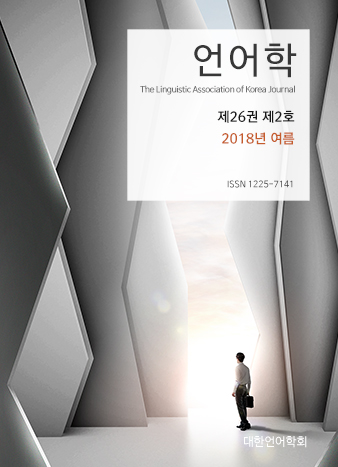대한언어학회 전자저널

-
The Why-not Construction in Korean: A Direct Interpretation Approach
-
L2 Acquisition of Raising Revisited: The Role of the Experiencer Phrase
-
How Universities in Korea and the US Position Themselves in Brochures
-
A Study of Learning Strategies in a Flipped Class Based on Logistic Regression Analysis
-
A Study on the Effects of a TETE Class on English Learners’ Motivation and Anxiety
-
Oral versus Written English Grammar: Evidence from Korean Adult Learners’ Data
-
The Effects of Dictogloss Tasks on EFL Learners’ Syntactic Development
26권 2호 (2018년 6월)
- 플립러닝 기반 힌디어 학습 모형 개발: 수업 유형 및 학생참여 동영상 강의를 중심으로
-
고태진
Pages : 199-227
Abstract
Keywords
# 주제어(Key Words): 플립러닝(flipped learning) # 학생참여 강의 동영상(student-engaged video lectures) # 힌디어 교육(Hindi education)
References
- 강남희. (2017). 플립러닝을 활용한 교양영어 교수학습 방안-일반영어와 특수목적영어(ESP) 도입. 한국영어교육학회 The Proceedings, 2017(1), 63-67.
- 권수옥. (2017). 플립 러닝이 문학작품을 이용한 영어교육에 미치는 효과. 영미문학교육, 21(3), 5-28.
- 김광민. (2009). 역량기반(competency-based) 교육의 매력과 한계. 도덕교육연구, 20(2), 171-197.
- 김동률. (2017). Flipped Learning이 대학수학의 학업성취도에 미치는 영향. 한국융합학회논문지, 8(6), 209-218.
- 김영배. (2015). 플립러닝(flipped learning) 지원시스템 설계 원리 개발. 부산대학교 박사학위 논문.
- 김예나래, 표경현. (2017). 플립러닝을 통한 영어수업에서의 자기 주도적 학습태도와 학업성취도 연구. 언어학연구, 45, 423-455.
- 김혜영. (2017). 영어교육관점으로서의 플립러닝의 이해. 한국영어교육학회 The Proceedings, 2017(1), 51-56.
- 김희봉. (2009). ISD의 다양성과 문제해결을 위한 확장적 사고 및 교수자의 역할. 학습과학연구, 3(2), 50-68.
- 박기범. (2014). 사회과 교육에서 플립러닝(Flipped Learning)의 교육적 함의. 사회과 교육, 53(3), 107-120.
- 방진하, 이지현. (2014). 플립드 러닝(Flipped Learning)의 교육적 의미와 수업 설계에서의 시사점 탐색. 한국교원연구, 31(4), 299-319.
- 배도용. (2015). 대학에서의 플립드 러닝 수업의 적용 사례 연구. 우리말연구, 41, 179-202.
- 변지현, 정규태. (2015). 거꾸로 교실을 적용한 영어과 원격기반 토론 수업 사례 연구. 언어연구, 31(3), 683-706.
- 서정목. (2015). 플립러닝을 활용한 영어교과목의 융복합적인 운영에 관한 연구: 스크린영어, SNS영어 및 TED영어를 중심으로. 교양교육연구, 9(3), 193-214.
- 소만섭. (2015). 플립드 러닝 기반 독일어문법 수업. 독어교육, 63, 7-27.
- 송지영, 임병빈. (2017). 플립러닝 수업이 대학생의 영어 듣기와 읽기 능력에 미치는 효과. 언어학연구, 22(2), 93-113.
- 이동엽. (2013). 플립드 러닝(Flipped Learning) 교수학습 설계모형탐구. 디지털융복합연구, 11(2), 83-92.
- 이승은, 김경훈. (2017). 플립러닝 활용 영어수업에서 학습양식이 학습자들의 학습 태도와 실패내성에 미치는 영향. 교육혁신연구, 27(3), 1-18.
- 이지연. (2014). 학습자 중심 플립드러닝(Flipped Learning) 수업의 적용 사례. 교육공학연구, 30(2), 163-191.
- 정희정. (2013). 영어학습에서 스마트러닝 사용의도에 미치는 변인들. 언어학, 21(3). 301-317.
- Alzain, H. (2015). The impact of the application of the concept of the inverted row in the academic achievement of students in the Faculty of Education Princess Nora bint Abdul Rahman University. The International Journal of Educational Specialist, 4(1), 171-186.
- Al-Zahrani, A. M. (2015). From passive to active: The impact of the flipped classroom through social learning platforms on higher education students’ creative thinking. British Journal of Educational Technology, 46(6), 1133-1148.
- Bajurny, A. (2014). An Investigation into the Effects of Flip Teaching on Student Learning. Unpublished master’s thesis, University of Toronto, Toronto, Canada. Retrieved June 06, 2018, from https://tspace.library.utoronto.ca/bitstream/1807/67002/1/Bajurny_Amy_E_2014April_MT_MTRP.pdf
- Bergmann, J., & Sams, A. (2012). Flip your classroom: Reach every student in every class every day. Arlington: International Society for Technology in Education.
- Garrison, D. R., Anderson, T., & Archer, W. (2000). Critical inquiry in a text-based environment: Computer conferencing in higher education. Internet and Higher Education, 2(2-3), 87–105.
- Lo, C. K., & Hew, K. F. (2017). A critical review of flipped classroom challenges in K-12 education: possible solutions and recommendations for future research. Research and Practice in Technology Enhanced Learning, 12(4), 1-22.
- Richard, P., & Streyer, J. F. (2012). Vodcast and active-learning exercises in a flipped classroom model of a renal pharmacotherapy module. American Journal of Pharmaceutical Education, 76(10), 1-5.
- Strayer, J. F. (2007). The effects of the classroom flip on the learning environment: A comparison of learning activity in a traditional classroom and a flip classroom that used an intelligent tutoring system. Unpublished doctoral dissertation, The Ohio State University, Columbus, Ohio.
- Strohmyer, A. (2015). Student perceptions of flipped learning in a high school math classroom. Unpublished doctoral dissertation, Walden University, Minneapolis, Minnesota.
- Tenneson, M., & McGlasson, B. (2006). The classroom flip. Retrieved December 02, 2017, from http://www.fontbonne.edu/upload/TheClassroomFlip.ppt
- Van Vliet, E. A., Winnips, J. C., & Brouwer, N. (2015). Flipped-class enhances student metacognition and collaborative-learning strategies in higher education but effect does not persist. Life Sci. Educ., 14, 1-10.